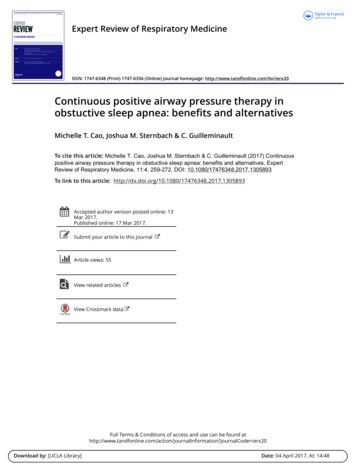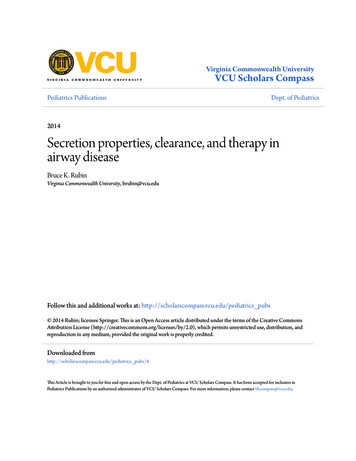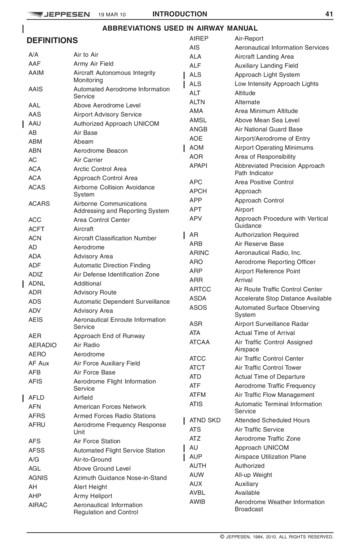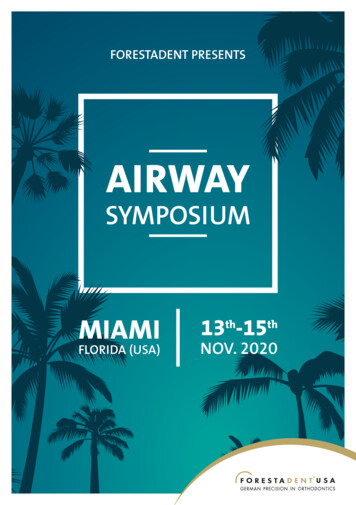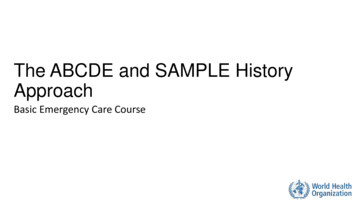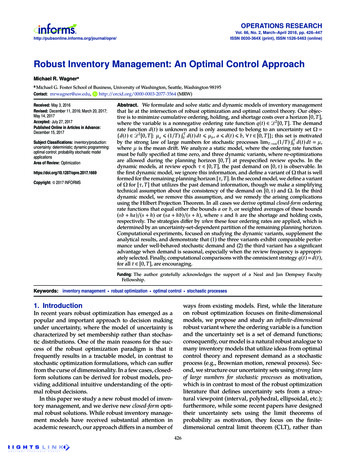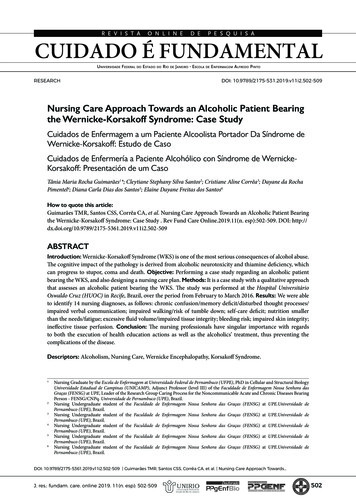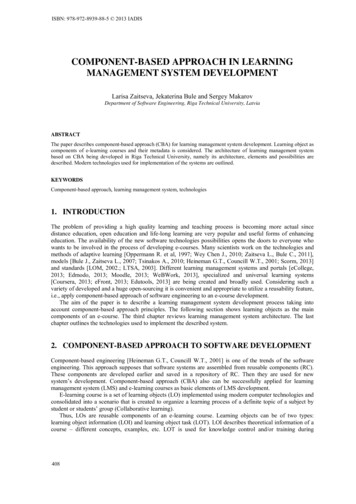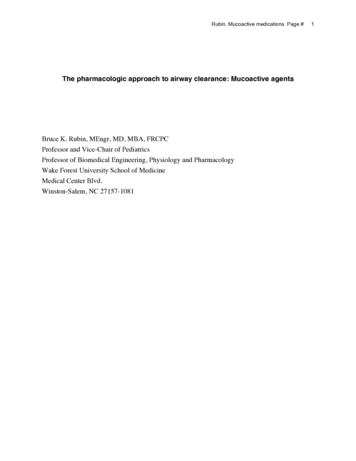
Transcription
Rubin. Mucoactive medications. Page #The pharmacologic approach to airway clearance: Mucoactive agentsBruce K. Rubin, MEngr, MD, MBA, FRCPCProfessor and Vice-Chair of PediatricsProfessor of Biomedical Engineering, Physiology and PharmacologyWake Forest University School of MedicineMedical Center Blvd.Winston-Salem, NC 27157-10811
Rubin. Mucoactive medications. Page #2Outline1. Introduction2. Expectorants3. Medications that change the biophysical properties of secretions3.1 Mucolytic agents3.1.1 Classic mucolytics3.1.2 Peptide Mucolytics3.1.3 Nondestructive mucolytics4. Mucokinetic agents5. Cough clearance promotors6. Mucoregulatory medications7. Summary1. IntroductionThe airway mucosa responds to infection and inflammation in a variety of ways. Thisresponse often includes surface mucous (goblet) cell and submucosal gland hyperplasia andhypertrophy with mucus hypersecretion. Products of inflammation including neutrophil derivedDNA and filamentous actin (F-actin), effete cells, bacteria, and cell debris all contribute tomucus purulence and, when this is expectorated it is called sputum. Mucoactive medications areintended to serve one of two purposes; either to increase the ability to expectorate sputum or todecrease mucus hypersecretion. Mucoactive medications have been classified according to theirproposed method of action (1). Sputum is expectorated mucus mixed with inflammatory cells,cellular debris, polymers of DNA and F-actin, as well as bacteria. Mucus is usually cleared byairflow and ciliary movement, and sputum is cleared by cough (2). In this review, I will discusseach of these classes of medication, their proposed mechanism of action, and their potential usein treating patients with chronic airways diseases associated with poor mucus clearance and withmucus hypersecretion.
Rubin. Mucoactive medications. Page #32. ExpectorantsExpectorants are defined as medications that are taken to improve the ability toexpectorate purulent secretions. This term is now taken to mean medications that increase airwaywater or the volume of airway secretions. The most commonly used of these are simplehydration including both bland aerosol administration and oral hydration, iodide containingcompounds such as SSKI or iodinated glycerol, glyceryl guaiacolate or guaifenesin, and themore recently developed ion channel modifiers such as the P2Y2 purinergic agonists. Most ofthese medications or maneuvers are ineffective at adding water to the airway and those that areeffective are also mucus secretagogues increasing the volume of both mucus and water in theairways. Despite widespread use, iodinated compounds, guaifenesin, and simple hydration areineffective as expectorants (3). In fact, over-hydration has been shown to decrease airway mucusclearance in some patients with chronic airway disease, particularly with acute asthma (4).For many years, sputum induction using hyperosmolar saline inhalation has been used toobtain specimens for the diagnosis of pneumonia. As summarized in the Cochrane Database, thelong term use of inhaled hyperosmolar saline improves pulmonary function in patients withcystic fibrosis (CF) (5) and inhaled hyperosmolar saline or mannitol is beneficial in non-CFbronchiectasis (6). Although this therapy is readily available and inexpensive, it has beenreported that hypertonic saline aerosol is not as effective as dornase alfa in the therapy of CFlung disease (7).Agents that increase transport across ion channels such as the CFTR chloride channel,calcium dependent chloride channel, or agents that increase water transport across the airwayaquaporin water channels may increase the hydration of the periciliary fluid and so may aidexpectoration. These medications (including gene transfer vectors) are actively beinginvestigated. Early results using UTP to stimulate chloride secretion or amiloride to blockepithelial sodium channels were disappointing in that these did not produce a sustained
Rubin. Mucoactive medications. Page #4improvement in pulmonary function in persons with CF (8) but newer P2Y2 chloride channelactivators appear to be more effective (9, 10).In general, expectorant medications have not been consistently demonstrated to beeffective for the treatment of airway disease associated with mucus stasis or hypersecretion.3. Medications that change the biophysical properties of secretionsThe principal polymer component of normal airway mucus is mucin glycoprotein. Themucin protein is heavily decorated with oligosaccharide side chains and the elongatedglycoproteins linearly polymerize and form a “tangled network” secondary structure. Thisaccounts for the gel structure of normal airway mucus. With chronic inflammation there isthought to be hypersecretion of mucin although this has not been proven. In fact it has beenshown that there is mucus hyposecretion in the CF airway (11) and this may predispose theairway to chronic infection with biofilm producing organisms. In sputum, a secondary polymernetwork comprised of neutrophil derived DNA and F-actin also forms within the airway. ThisDNA forms rigid polymer chains that copolymerize with cell wall associated actin (12). Thissecondary polymer network is responsible for many of the abnormal properties of purulentsecretions.3.1 MucolyticsMucolytic medications depolymerize either the mucin network (classic mucolytics) or theDNA-actin polymer network (peptide mucolytics) and in so doing reduce the viscosity andelasticity of airway secretions. Mucus has viscoelastic properties of both liquids (viscosity) andsolids (elasticity). Thus it is a gel and both the viscous (energy loss) and elastic (energy storage)properties are essential for mucus spreading and clearance (13). Mucociliary clearance appears tobe dependent upon there being an optimal ratio of viscosity to elasticity (14). Mucolytic agentshave the potential to improve mucus rheology thus improving mucociliary or cough clearance,
Rubin. Mucoactive medications. Page #5but these medications are also potentially able to over liquify secretions and this would decreaseclearance (15).3.1.1 Classic MucolyticsClassic mucolytics depolymerize the mucin glycoprotein oligomers by hydrolyzing thedisulfide bonds linking the mucin monomers. This is usually accomplished by free thiol(sulfhydryl) groups hydrolyzing disulfide bonds attached to cysteine residues of the protein core.The best known of these agents is N-acetyl L-cysteine (NAC) which is widely used for thetreatment of chronic bronchitis in Europe and Asia. There are few data available from placebocontrolled clinical trials of NAC or its derivatives, and these data do not demonstrate that NACimproves mucus clearance or pulmonary function (16). The aerosol is available in the UnitedStates but is often poorly tolerated by patients because of its sulfurous odor and because the pHof 2.2 is associated with bronchospasm. NAC is an antioxidant and has been used to treatacetaminophen overdose. The orally available compound is also available in Europe but despitebeing a potent anti oxidant there are no data demonstrating that this medication is effective in thetreatment of chronic airway disease (17).There are a number of similar compounds containing sulfhydryl groups that caneffectively depolymerize mucin polymers in vitro. Although many of these are better toleratedthan NAC, none have been clearly demonstrated to be effective in improving mucus clearance.3.1.2 Peptide mucolyticsThe mucin polymer network is essential for normal mucus clearance. It may be that theclassic mucolytics are generally ineffective because they are depolymerizing essentialcomponents of the mucous gel. With airway inflammation and inflammatory cell necrosis, asecondary polymer network develops in purulent secretions. In contrast to the mucin network,this pathologic polymer gel serves no obvious purpose in airway protection or mucus clearance.
Rubin. Mucoactive medications. Page #6The peptide mucolytics are designed specifically depolymerize the DNA polymer (dornase alfa)or the F-actin network (e.g. gelsolin, thymosin beta 4).Dornase alfa has seen wide acceptance as a peptide mucolytic for the treatment of cysticfibrosis airway disease (18). When used as prescribed, its use is associated with improvedpulmonary function, decreased antibiotic use, and decreased hospitalization rate for manypatients with CF (19). For reasons that are not clear, this medication is not uniformly effectivefor the treatment of CF airway disease and efficacy does not seem to be related to sputum DNAcontent. There are limited and anecdotal data suggesting that dornase alfa may be effective intreating some persons with non CF bronchiectasis including some patients with primary ciliarydyskinesia (20). Although dornase alfa was not effective for the therapy of severe chronicbronchitis, there are no published studies evaluating its potential efficacy in patients with milderdisease.Both gelsolin and thymosin ß4 have been demonstrated to depolymerize the pathologicDNA/F-actin network in CF sputum. These agents have never been studied in controlled clinicaltrials.3.1.3 Nondestructive mucolyticsMucin is a polyionic tangled network and the charged nature of the oligosaccharide sidechains help to hold this network together as a gel. Several agents have been proposed that can“loosen” this network by charge shielding. Such agents include low molecular weight dextran,heparin, and other sugars or glycoproteins (21).4. Mucokinetic agentsA mucokinetic medication is a drug that increases mucociliary clearance, generally byacting on the cilia. Although a variety of medications such as tricyclic nucleotides, beta agonistbronchodilators, and methylxanthines bronchodilators have all been demonstrated to increaseciliary beat frequency, these agents have only a minimal effect on mucociliary clearance in
Rubin. Mucoactive medications. Page #7patients with lung disease (22). The reason for this is probably a combination of factors includingthe limited potential for efficacy in an airway with dysfunctional cilia or denuded of cilia. Mostof these agents are also mucus secretagogues which may paradoxically increase the burden ofairway secretions. Bronchodilator medications can also increase airway collapse in patients withbronchomalacia by virtue of their ability to relax airway smooth muscle. Therefore, the onlypersons for whom these medications are recommended are those who have improvement inexpiratory airflow following their use. Increased expiratory airflow can enhance the effectivenessof cough (23). Thus bronchodilators might be better considered cough clearance promotors asdescribed below.5. Cough clearance promotorsCough becomes a major mechanism for mucus clearance when there is extensive ciliarydamage and mucus hypersecretion. Cough clearance depends on expiratory airflow, volume, andforce, and the biophysical properties of airway secretions. In general, decreasing theviscoelasticity of airway secretions will not improve cough clearance unless this therapy alsoreleases mucus from adherent entanglements with cilia. As mucus becomes adherent to theepithelium, it becomes far more difficult to expectorate. Patients who appear to benefit fromexpectorants or mucolytic agents may do so by virtue of these medications releasing mucus fromepithelial attachment.Agents that reduce the adhesivity of airway secretions and thus binding to the epitheliumare the abhesives. There is a thin layer of surfactant that serves to separate the periciliary fluidand the cilia from the mucous layer permitting effective ciliary function and preventing secretionadherence to the epithelium. With airway inflammation, there is extensive surfactant hydrolysisby secretory phospholipases A2 (sPLA2) and the generation of lysophospholipids that appear toincrease mucus adhesivity (24). It has been shown that aerosolized surfactants are effectiveabhesives and can significantly improve both cough clearability of secretions and pulmonaryfunction in patients with chronic bronchitis (25).
Rubin. Mucoactive medications. Page #8Earlier generations of Venturi-driven jet nebulizers made it difficult to efficientlyaerosolize surfactant as this medication foams extensively and coats surfaces. Newer aerosoldelivery devices permit surfactant to be administered efficiently either as a dry powder or as awet aerosol. Studies are planned evaluating the potential effectiveness of surfactant for patientswith chronic airway diseases using some of these newer modes of drug delivery.6. Mucoregulatory medicationsAnother approach to reducing the burden of airway secretions is to decreasehypersecretion by goblet cells and submucosal glands. Medications that decrease mucushypersecretion are referred to as mucoregulatory medications. These medications include antiinflammatory drugs such as corticosteroids which are effective at decreasing the inflammatorystimulus that leads to mucus hypersecretion. Aerosolized indomethacin has also been used inJapan to treat patients with diffuse panbronchiolitis who have impairment due to mucushypersecretion (26).Anticholinergic medications are also extensively used as mucoregulatory medications.Atropine is routinely given peri-operatively to prevent laryngospasm and to decrease mucussecretion associated with endotracheal intubation. Atropine and its derivatives aremucoregulatory medications in that they do not “dry” secretions but will decrease hypersecretionthat is mediated through M3 cholinergic mechanisms. The quaternary ammonium derivatives ofatropine including ipratropium bromide and tiotropium do not significantly cross the bloodairway barrier and as such, their use is not associated with typical systemic effects ofanticholinergic medications such as flushing or tachycardia. Ipratropium bromide is widely usedas a bronchodilator medication in patients with chronic bronchitis. Studies have also shown thatthe long-term use of ipratropium is associated with a re
ineffective as expectorants (3). In fact, over-hydration has been shown to decrease airway mucus clearance in some patients with chronic airway disease, particularly with acute asthma (4). For many years, sputum induction using hyperosmolar saline inhalation has been used to obtain specimens for the diagnosis of pneumonia. As summarized in the Cochrane Database, the
